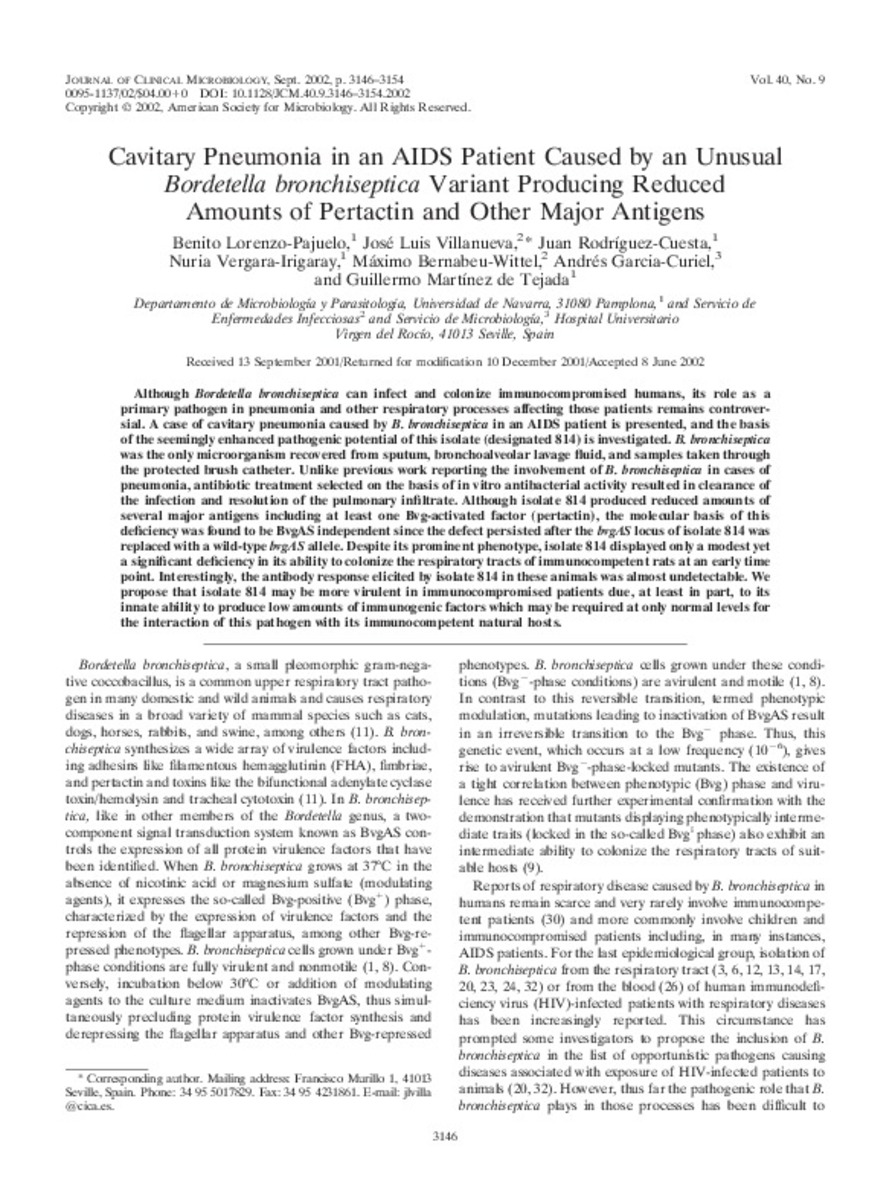Full metadata record
| DC Field | Value | Language |
|---|---|---|
| dc.creator | Lorenzo, B. (Benito) | - |
| dc.creator | Villanueva, J.L. (José Luis) | - |
| dc.creator | Rodriguez-Cuesta, J. (Juan) | - |
| dc.creator | Vergara, N. (Nuria) | - |
| dc.creator | Bernabeu, M. (Máximo) | - |
| dc.creator | Garcia-Curiel, A. (Andrés) | - |
| dc.creator | Martinez-de-Tejada, G. (Guillermo) | - |
| dc.date.accessioned | 2013-07-18T11:49:57Z | - |
| dc.date.available | 2013-07-18T11:49:57Z | - |
| dc.date.issued | 2002 | - |
| dc.identifier.citation | Lorenzo-Pajuelo B, Villanueva JL, Rodriguez-Cuesta J, Vergara-Irigaray N, Bernabeu-Wittel M, Garcia-Curiel A, et al. Cavitary pneumonia in an AIDS patient caused by an unusual Bordetella bronchiseptica variant producing reduced amounts of pertactin and other major antigens. J Clin Microbiol 2002 Sep;40(9):3146-3154. | es_ES |
| dc.identifier.issn | 0095-1137 | - |
| dc.identifier.uri | https://hdl.handle.net/10171/29509 | - |
| dc.description.abstract | Although Bordetella bronchiseptica can infect and colonize immunocompromised humans, its role as a primary pathogen in pneumonia and other respiratory processes affecting those patients remains controversial. A case of cavitary pneumonia caused by B. bronchiseptica in an AIDS patient is presented, and the basis of the seemingly enhanced pathogenic potential of this isolate (designated 814) is investigated. B. bronchiseptica was the only microorganism recovered from sputum, bronchoalveolar lavage fluid, and samples taken through the protected brush catheter. Unlike previous work reporting the involvement of B. bronchiseptica in cases of pneumonia, antibiotic treatment selected on the basis of in vitro antibacterial activity resulted in clearance of the infection and resolution of the pulmonary infiltrate. Although isolate 814 produced reduced amounts of several major antigens including at least one Bvg-activated factor (pertactin), the molecular basis of this deficiency was found to be BvgAS independent since the defect persisted after the bvgAS locus of isolate 814 was replaced with a wild-type bvgAS allele. Despite its prominent phenotype, isolate 814 displayed only a modest yet a significant deficiency in its ability to colonize the respiratory tracts of immunocompetent rats at an early time point. Interestingly, the antibody response elicited by isolate 814 in these animals was almost undetectable. We propose that isolate 814 may be more virulent in immunocompromised patients due, at least in part, to its innate ability to produce low amounts of immunogenic factors which may be required at only normal levels for the interaction of this pathogen with its immunocompetent natural hosts. | es_ES |
| dc.language.iso | eng | es_ES |
| dc.publisher | American Society for Microbiology | es_ES |
| dc.rights | info:eu-repo/semantics/openAccess | es_ES |
| dc.subject | Filamentous hemagglutinin | es_ES |
| dc.subject | Pertussis | es_ES |
| dc.subject | Infection | es_ES |
| dc.subject | Parapertussis | es_ES |
| dc.subject | Identification | es_ES |
| dc.subject | Virulence | es_ES |
| dc.subject | Bacteria | es_ES |
| dc.subject | Locus | es_ES |
| dc.subject | Host | es_ES |
| dc.subject | Microbiology | es_ES |
| dc.title | Cavitary pneumonia in an AIDS patient caused by an unusual Bordetella bronchiseptica variant producing reduced amounts of pertactin and other major antigens | es_ES |
| dc.type | info:eu-repo/semantics/article | es_ES |
| dc.type.driver | info:eu-repo/semantics/article | es_ES |
| dc.identifier.doi | http://dx.doi.org/10.1128/JCM.40.9.3146–3154.2002 | es_ES |
Files in This Item:
Statistics and impact
Items in Dadun are protected by copyright, with all rights reserved, unless otherwise indicated.






